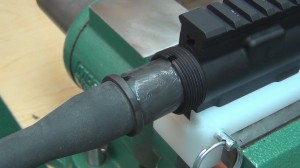The chamber end of the barrel has threads that the barrel extensions screws onto. There is a hole in the barrel extension throught which an indexing pin is driven. This deforms the threads, keeping the barrel extension from rotating. When you buy a barrel, it will usually come with the barrel extension already installed. This indexing pin fits into a slot in the upper receiver. When machined to spec., you just slide this locating pin into the slot in the upper receiver and then tighten the barrel nut.
This indexing pin also takes care of aligning the gas port in the barrel so it is vertical . This in turn will make the front sight/gasblock vertical. To help align the gas block with the gas port, there are a couple of slots machined into the bottom surface of the barrel. Roll pins go through the gas block and pass throught those slots to hold the gas block on. On some barrels, meant to take a low profile gas block, there are dimples on the bottom of the barrel to set screw the gas block in place.

See barrel installation
here
Since the bolt locks into the barrel extension, it and the barrel extension contain the stresses when the rifle is fired. Bolt specifications (Carpenter 158 steel. There are much better grades of steel available today), call for a hardened and shot peened bolt. That is why you can get by with an aluminum upper and lower receiver. There are four raised longitudinal ribs on the bolt carrier. These are the only parts of the bolt carrier that touch the upper receiver. The bolt carrier moves back and forth in the upper receiver and as it moves forward, it causes the extended bolt to run into the barrel extension. As inertia keeps the bolt carrier moving forwards, the back of the bolt is forced back into the bolt carrier. This makes the cam pin move along its curved raceway, causing the bolt to rotate. This then locks the bolt into the barrel extension.
The three lock rings on the bolt are gas rings. They do help center the bolt in the bolt carrier (a little bit) but that is not their primary function.
Many of today's hunting rifle bolt actions have locking lugs that do not bear equally on the receiver. You can blacken the lugs with a marker, close the bolt and often you will find that (maybe) only one lug is making full metal to metal contact. The guns are still reasonably accurate. Of course, if you want benchrest accurace, you will spend a lot of time to ensure even contact of the lugs. In the AR-15, as long as the bolt rotates closed (locking into the barrel extension), it should hold the base of the cartridge tight up against the chamber.
There is a bit of play in the bolt when it sits in the bolt carrier. You can wiggle it a tiny bit when it is fully extended out of the bolt carrier. It is not rigid like the bolt in a bolt action rifle. The only thing holding the bolt into the bolt carrier is the cam pin (which must be free to move in its raceway). If you notice the lugs in the barrel extension are somewhat ramped; so alignment doesn't have to very precise for the bolt to enter it. The bolt doesn't have to be held rigidly centered in the bolt carrier, unlike the lugs in a bolt action rifle. It is usually precise enough. If you look at a close-up photo of the barrel extension, you will notice that the lugs in there are ramped on both sides. I hope this answers your question about bolt alignment?
Backward pressure produced when the cartridge fires, is contained by the bolt being locked up in the barrel extension. Once the gas comes through the gas tube, impinging on the "gas key", it forces the bolt carrier backwards. This causes the cam pin to move its raceway, which in turn rotates the bolt, unlocking it. Once the bolt is fully unlocked the bolt carrier is able to withdraw it from the barrel extension. As the bolt withdraws, the extractor pulls the cartridge out and the ejector in the bolt head kicks it loose of the bolt, sending it out through the ejection port.
Today's machine can hold incredibly tight tolerances. Even the machine tools in the 1950's and 1960's could hold very tight tolerances compared to what is necessary to machine AR-15 parts. $100,000 will buy you a five axis machining center that will easily do any of this stuff and then some. Even a small machine shop can afford those. Some small gun manufacturers whose shops (that I have toured) have just a handful of employees and can afford a few of those machines. That is what I meant when I said that the machining requirements are not onerous.
For shooting with the head erect:
The AR15 stock is placed very high as the bolt carrier recoils partially into the buffer tube to which the stock is attached. In fact, it is inline with the bore. Look at your average bolt action rifle and you will notice how much the stock drops compared to the bore. You can still get a cheek weld on an AR-15, in fact, for good shooting, you must get a decent cheek weld. Look a the video of us bumpfiring and you will see us getting a cheek weld.
My scope is really not that low. If you look at the scope mounts, you will notice how high they are above the bore. The sights are approx 2.5" above the centerline of the
bore. What I think you are looking at, is the ocular and objective distance above the handguard and the top of the receiver. The picatinny rail on top of the receiver is raised up a bit. Look at the above barrel installation photo. The handguard is also above the bore.








